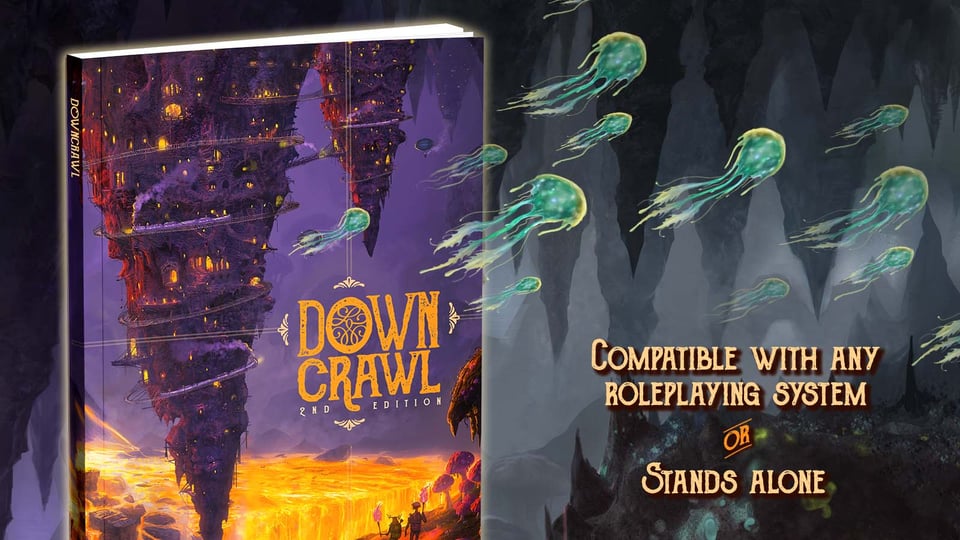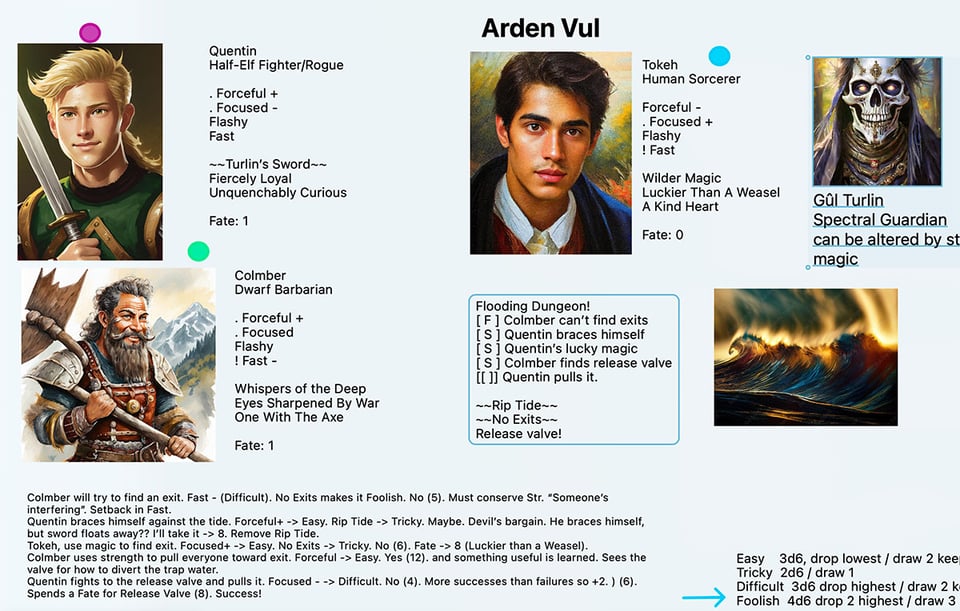Downcrawl: Sliver of Fate
All the details on Downcrawl's new standalone roleplaying engine.
It’s Week 2 of the Downcrawl 2E crowdfunding campaign! Consider joining us on this expedition if you haven’t already. We saved a pack for you!

I want to talk in this update about Sliver of Fate, Downcrawl 2E’s built-in game engine. [Note: this post was updated 12/16/24 with some tweaks to the Sliver of Fate rules.] The original edition of the game was essentially a system-neutral expansion for a full roleplaying game like D&D or Fate: you couldn’t play it standalone. While you can still add it on to an existing engine in 2E, Downcrawl now comes with a ready-made RPG engine for out-of-the-box adventures: Sliver of Fate.
The system is so-named because it’s inspired by the long-running and popular RPG system Fate, although with some significant changes. For one, Sliver is a deliberately minimalist system, even more so than the official “smaller” version of Fate (Fate Condensed). Why? It’s because I wanted a system that could mostly get out of your way so players could focus on Downcrawl’s unique rules for journeys, fungal foraging, inventing weird places and peoples, and so on… while still retaining just enough complexity to allow for interesting choices and to sustain a long-running campaign.
(Because of that minimalism, Sliver is likely not a great fit if you prefer your roleplaying engines with detailed combat mechanics or complex skill trees. But if you want something just complex enough to scaffold some ongoing adventures, I think it does a pretty good job.)
Characters in Sliver of Fate are simple enough to fit on an index card. They’re comprised of three elements all inspired by Fate (Approaches, Aspects, and Fate points) but the way you use them is a bit different. Briefly:
Approaches are ways you might go about handling any particular problem: rather than particular skills, they’re generalized styles. Sliver of Fate has four: Forceful, Focused, Flashy, and Fast. Each player character is especially good at one and especially bad at another.
Aspects represent your character’s unique skills, gear, style, or stunts: they might be things like Expert Duelist, Silver Tongue, or Keeper of the Sacred Book.
Fate is a currency earned as you play (and particularly as you fail), spent to influence outcomes.

The core move in Sliver is called Face a Challenge: this is the go-to “make a roll” move of the system. When you Face a Challenge, you follow these steps:
Pick an Approach you might sensibly use to solve this problem, which sets a difficulty rank. It’s Tricky to solve most problems, but Easy if using your good approach, and Difficult if using your bad one.
Mark the Approach to indicate you’ve used it since you last cleared marks. When all four Approaches are marked, you clear the marks and earn Fate. (This encourages you to use the full range of Approaches, not just the one you’re best at. In the photo above, I’m using paperclips to mark Approaches.)
Increase the difficulty if this challenge is especially hard (or in a few other circumstances described later).
Finally, roll based on the difficulty. For instance, for an Easy challenge you roll 3d6 and drop the lowest.
Your roll determines the outcome of this challenge:
On a 7-, you can choose to either:
Conserve your strength: fail this roll, but earn 1 Fate
Push for success: either invoke a narratively relevant Aspect and spend 1 Fate, or give yourself a Setback in an Approach or Aspect (preventing your ability to invoke it again until you rest), in either case gaining a +2 to your result.
On a 8+, you succeed.
When you face more complex and dangerous situations, a second move kicks in: Fight To Survive. This might be used for a literal fight scene, a chase, a natural disaster, or even a tense diplomatic negotiation with serious consequences. I won’t describe this move as fully, but a key point is that when you Fight to Survive, you’ll create one or more Scene Aspects representing dangerous abilities or environmental advantages benefiting your opponents.
Scene Aspects have a couple effects. If any apply, they increase the difficulty rank of challenges during your Fight to Survive until they’re dealt with. There’s also a way to create beneficial Scene Aspects, which allies can use to aid you. This creates an interesting tension between addressing the immediate problem and setting yourself or your friends up for future victory, which is echoed in a few other parts of the system (conserving strength vs pushing for success, for instance).
There are a few other wrinkles in Sliver not described here. (Failing a challenge roll can result in taking a Setback; Fight To Survive builds up to a climactic roll where successes and failures so far influence the final outcome.) But that’s the system in a nutshell.
As I said, it’s quite minimalist, but a lot of thought was put into how to carefully streamline it to provide just enough structure to support the rest of Downcrawl’s play. I’ve spent endless hours playtesting it both alongside Downcrawl and, as a standalone engine, I’ve used it to explore enormous megadungeon Arden Vul (with naive hero Quentin, his long-suffering sorcerer boyfriend, an old dwarven war buddy of his dead father, and an inquisitive skeleton they met along the way…)

Once you’ve got the system down, it gets out of your way quite nicely in play. It’s not doing anything particular new or innovative, but most of the tiny systems I’ve seen tend to be more focused on OSR-style stats and combat loops, so I’m proud of the way Sliver provides a similarly minimalist framework that supports more story-driven adventures.
You can download a standalone version of Sliver of Fate here, if you’re curious to check it out. (The version included in Downcrawl has some additional notes about how to incorporate it into that game.)
I blog here every week or two about Downcrawl’s rules and systems: if you’re not subscribed, you’re welcome to join to get updates via email! (There’s also an RSS feed.)
I’ll also be live-streaming Solo Downcrawl again this Thursday at 5pm PT. Come join us for the continuing adventures of a living puppet witch hunter as he finally reaches the Crimson Wasteland, where an ancient evil lies imprisoned in a red-hot pyramid… hopefully. (I’ve also posted some highlights from the stream showcasing different moves and features of the game, if you’re curious.) I’d love to see you on the next stream!